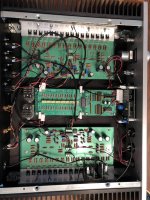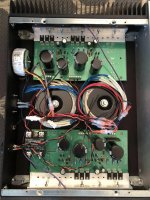So there is a buzzing / humming sound on the right channel of the amp which stays constant with volume changes and can be "heard over music playing"
The cables are all connected properly and the power source is clean.
I would appreciated debugging steps !
thank you
The cables are all connected properly and the power source is clean.
I would appreciated debugging steps !
thank you
Attachments
This crops up here more and more and I and others have posted very long lists of the many types of radiated noise it could be as well as induced /CM etc etc.
20 years ago I purchased a miniature detector from Maplin (UK) now defunct that gave an audible indication of the area the problem was occurring in.
With so many posts of this nature I rechecked the availability of gadgets like mine ( which is handy for picking up HF oscillation in a self build amplifier, sadly both price + size have vastly increased in 2021 , size is due to added visual indications etc when a simple version would do at a cheaper price .
Here is a variety of EMF/RF pickup locators -
7 Best EMF Meters and Detectors of 2020 - EMF Academy
and DIY versions ( but mainly for RF )-
Simple RF Detectors
20 years ago I purchased a miniature detector from Maplin (UK) now defunct that gave an audible indication of the area the problem was occurring in.
With so many posts of this nature I rechecked the availability of gadgets like mine ( which is handy for picking up HF oscillation in a self build amplifier, sadly both price + size have vastly increased in 2021 , size is due to added visual indications etc when a simple version would do at a cheaper price .
Here is a variety of EMF/RF pickup locators -
7 Best EMF Meters and Detectors of 2020 - EMF Academy
and DIY versions ( but mainly for RF )-
Simple RF Detectors
If it's EMF you will hear it change as you move your cables around plus it should go up and down with the volume and you say this doesn't. If you know what 60 hz sounds like and that is what you are hearing then you likely have AC from your power supply getting into your audio path which is almost always a capacitor problem. If you have a capacitance meter, the quickest troubleshooting approach will be to test all the caps around the low voltage input stage first. If you don't find it there then test the caps on the high voltage output stage.
If you don't have a C-meter, you can get one for under $20 on Amazon that does a good job of testing caps on the board - search for "Honeytek A6013L Capacitor Tester". If you have a schematic it will be easier for me and others to help you.
If you don't have a C-meter, you can get one for under $20 on Amazon that does a good job of testing caps on the board - search for "Honeytek A6013L Capacitor Tester". If you have a schematic it will be easier for me and others to help you.
By constant with volume changes do you mean that the buzz is proportional to volume changes or stays the same regardless of the volume? That will give you a clue about what stage the hum is being introduced.
You are fortunate that nothing is shared between left, right, +, and -. First put a constant tone through the amp and try putting a diode in series with the left in both directions to get a reference. It will reduce the sound to a faint constant frequency tick. Then do the same on the right channel. The tick will sound different in one particular direction from the other 3 tests. That will let you know whether it's the + or - side.
Unplug the amp and check all of your transistors in that section first with a multimeter because that can be done on the board. There should be no shorts or open circuits. You can use other working sections for reference from any particular leg to leg of a transistor.
If they're all good then you need to remove the caps and test them. A quick way to check is with your MM on resistance, short then charge the cap with the proper polarity. The resistance should climb slowly to infinite or very close. If it climbs quickly or stops climbing before 10Meg then it's toast. Short and charge it again in reverse polarity. All caps are different when used incorrectly but it should climb about twice as fast as forward polarity then stop around 5-15Meg.
If you still haven't figured it out then just start replacing parts or swap them out with the left channel until the problem changes. There is also a very good chance that more than one component is bad. A bad cap can hurt the first input transistor of a channel driver and then take out all of the other transistors downstream. Since you still have sound this is probably not the case (yet).
You are fortunate that nothing is shared between left, right, +, and -. First put a constant tone through the amp and try putting a diode in series with the left in both directions to get a reference. It will reduce the sound to a faint constant frequency tick. Then do the same on the right channel. The tick will sound different in one particular direction from the other 3 tests. That will let you know whether it's the + or - side.
Unplug the amp and check all of your transistors in that section first with a multimeter because that can be done on the board. There should be no shorts or open circuits. You can use other working sections for reference from any particular leg to leg of a transistor.
If they're all good then you need to remove the caps and test them. A quick way to check is with your MM on resistance, short then charge the cap with the proper polarity. The resistance should climb slowly to infinite or very close. If it climbs quickly or stops climbing before 10Meg then it's toast. Short and charge it again in reverse polarity. All caps are different when used incorrectly but it should climb about twice as fast as forward polarity then stop around 5-15Meg.
If you still haven't figured it out then just start replacing parts or swap them out with the left channel until the problem changes. There is also a very good chance that more than one component is bad. A bad cap can hurt the first input transistor of a channel driver and then take out all of the other transistors downstream. Since you still have sound this is probably not the case (yet).
Last edited:

